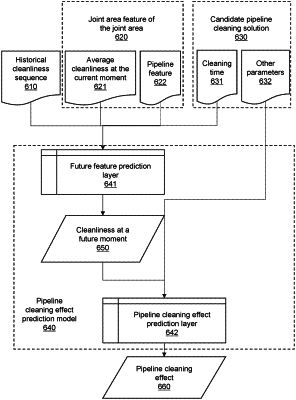| CPC B08B 9/0551 (2013.01) [B08B 2209/053 (2013.01)] | 8 Claims |

|
1. A method of smart gas pipeline cleaning management for safety management, implemented based on a smart gas equipment management platform of an Internet of Things system of smart gas pipeline cleaning management for safety management, comprising:
obtaining operation feature of at least one gas pipeline and inspection data of the at least one gas pipeline;
determining an area to be cleaned and an area feature of the area to be cleaned based on the operation feature of the at least one gas pipeline and the inspection data of the at least one gas pipeline;
determining a pipeline cleaning solution based on the area feature of the area to be cleaned; and
evaluating a pipeline cleaning effect of the pipeline cleaning solution based on an implementation of the pipeline cleaning solution; wherein the determining a pipeline cleaning solution based on the area feature of the area to be cleaned includes:
determining at least one joint area and a joint area feature of each of the at least one joint area through merging one or more gas pipelines contained in the area to be cleaned based on a preset method; and
determining a target pipeline cleaning solution of the at least one joint area based on the joint area feature of the at least one joint area; wherein the determining a target pipeline cleaning solution of the at least one joint area based on the joint area feature of the at least one joint area includes:
generating at least one candidate pipeline cleaning solution based on the joint area feature of the at least one joint area;
determining a pipeline cleaning effect of each of the at least one candidate pipeline cleaning solution through processing each of the at least one candidate pipeline cleaning solution and the joint area feature of the joint area based on a pipeline cleaning effect prediction model; and
determining the target pipeline cleaning solution of the at least one joint area based on the pipeline cleaning effect of each of the at least one candidate pipeline cleaning solution; wherein
the pipeline cleaning effect prediction model includes a future feature prediction layer and a pipeline cleaning effect prediction layer, the future feature prediction layer and the pipeline cleaning effect prediction layer are obtained by joint training based on training samples and labels, wherein the training samples include a sample historical cleanliness sequence, a joint area feature of a sample joint area, and a sample pipeline cleaning solution, the joint area feature of the sample joint area includes a sample cleanliness at a current moment and a sample pipeline feature, and the sample pipeline cleaning solution includes sample pipeline cleaning time and other sample parameters, and the labels include a sample pipeline cleaning effect, the joint training including:
inputting the sample historical cleanliness sequence, the sample cleanliness at the current moment, and the sample pipeline feature, and the sample pipeline cleaning time into an initial future feature prediction layer and obtaining cleanliness at a future moment output from the initial future feature prediction layer;
inputting the cleanliness at the future moment and the other sample parameters into an initial pipeline cleaning effect prediction layer and obtaining the pipeline cleaning effect output from the initial pipeline cleaning effect prediction layer;
constructing a loss function based on the sample pipeline cleaning effect and the pipeline cleaning effect output from the initial pipeline cleaning effect prediction layer;
updating parameters of the initial future feature prediction layer and the initial pipeline cleaning effect prediction layer simultaneously; and
obtaining the future feature prediction layer and the pipeline cleaning effect prediction layer.
|